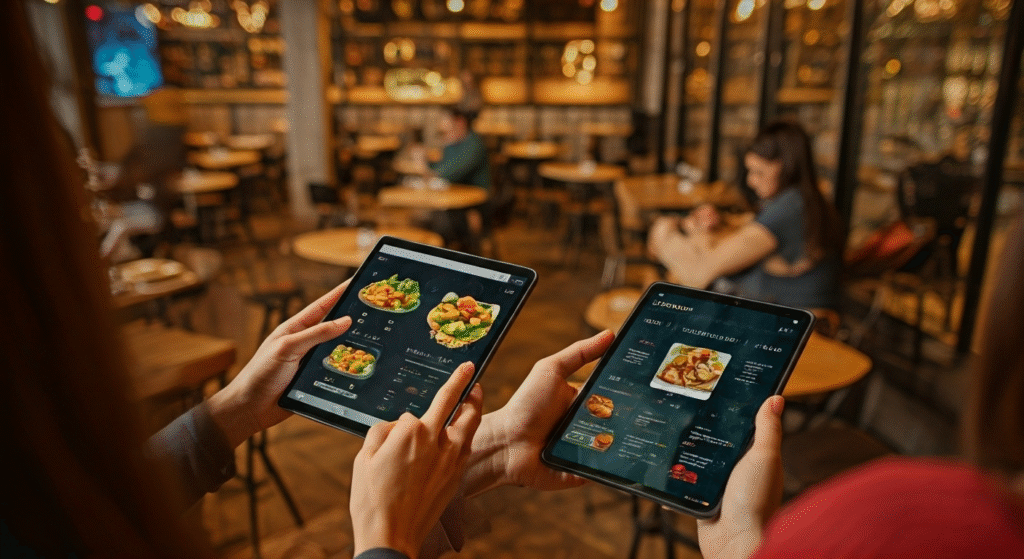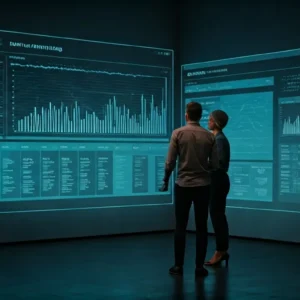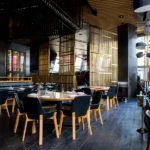Key Highlights
-
Digital menus and contactless ordering are reshaping the restaurant industry by delivering safer, more efficient dining solutions.
-
QR code scanning allows instant access to digital menus, enhancing convenience while ensuring hygiene standards.
-
Restaurants benefit from real-time menu updates, which reduce printing costs and improve operational efficiency.
-
Contactless ordering improves customer experience by reducing wait times and enabling quicker, error-free service.
-
Enhanced personalization allows restaurants to suggest special deals, boost upselling opportunities, and increase revenue.
-
Seamless integration of digital payments and ordering systems enhances customer satisfaction and loyalty.
Introduction
Digital menus and contactless ordering systems are revolutionizing the way diners experience restaurants. These tools have become vital for providing safe and efficient dining experiences, especially in the fast-evolving food industry. By eliminating physical menus and lengthy wait times, restaurants can streamline operations and create a more personalized environment for their patrons. Whether you’re looking for convenience, safety, or tailored service, adopting these innovative solutions promises to elevate the dining experience to new heights.
The Rise of Digital Menus and Contactless Ordering in Canada
The Canadian restaurant industry is embracing digital menus and contactless ordering. These solutions are not just necessities post-pandemic but are now shaping the modern dining experience. Through QR codes and mobile ordering, customers avoid handling physical menus, fostering a more hygienic environment.
This shift aligns with changing customer preferences, offering convenience and safety. Restaurant owners can adapt menus in real-time while optimizing processes to meet rapid changes in demand. These digital advancements are setting high standards, making innovative practices a cornerstone of the industry today.
Shift in Consumer Preferences Post-Pandemic
The pandemic profoundly influenced how customers interact with restaurants, with preferences shifting toward safer, contactless solutions. Physical menus once considered indispensable are now seen as outdated due to hygiene concerns. This led to an overwhelming demand for digital alternatives that minimize touchpoints and enhance convenience.
The trend toward contactless ordering reflects broader customer demographics seeking efficiency without sacrificing safety standards. Families, young diners, and seniors alike appreciate the reduced health risks and user-friendly features of digital systems. Integration of mobile apps has further bridged the gap, improving accessibility across age ranges.
Restaurant owners have recognized these emerging preferences, investing in smart, touch-free technologies that cater to health-conscious patrons. By addressing safety concerns while providing seamless interaction, contactless solutions are transforming dining into a more personalized, enjoyable experience for everyone.
Technology Adoption in Canadian Hospitality
The hospitality sector has witnessed a surge in the adoption of digital solutions that revolutionize traditional practices. Early adopters in Canada’s food service industry have found these innovative technologies indispensable, especially for improving order management and payment systems.
Automation has opened doors to faster processing, cutting down long wait times during peak hours. Seamlessly integrated contactless systems, such as QR codes and payment platforms, offer customer service that’s both efficient and futuristic. These technologies have created smoother operations while boosting satisfaction.
Restaurants that leverage digital innovations are staying ahead by analyzing customer data for valuable insights into dining preferences and trends. This allows businesses to create targeted marketing strategies, optimizing operations and engaging guests with tailored solutions. In the age of technology, adapting to these systems is no longer a choice but a necessity for long-term success.
Key Benefits of Digital Menus for Restaurants
Digital menus have become game-changers for restaurant owners seeking to enhance operations and customer engagement. These tools provide flexibility in updating menu items while doing away with the expenses of printing physical menus.
The features of digital menus go beyond convenience; they enable creative marketing strategies that lead to upselling and revenue growth. By fostering stronger interactions with customers through visual appeal and detailed information, restaurants can elevate customer experiences and build lasting loyalty.
Real-Time Menu Updates and Flexibility
The advantage of real-time menu updates is revolutionizing how restaurants manage offerings. Digital menus allow instantaneous adjustments to menu items, such as introducing seasonal dishes or accommodating stock limitations.
Inventory management becomes more agile with real-time updates. Chefs can track ingredients, reduce food waste, and optimize supply to prevent shortfalls. Customers appreciate online menus that consistently reflect availability while providing transparency about pricing or specific dietary details.
Additionally, digital menus offer detailed descriptions and food imagery, helping diners make informed choices. Restaurants can ensure that changes are communicated promptly, creating a more interactive and trustworthy atmosphere. The flexibility offered boosts overall efficiency and customer satisfaction.
Enhanced Upselling Opportunities and Personalization
The personalization features of digital menus open the door to diverse upselling strategies. Restaurants can use AI-driven insights to recommend special deals, loyalty programs, and exclusive combos tailored to individual dining preferences.
Upselling opportunities arise when guests explore menu categories with suggestions for add-ons, such as complementary appetizers or drinks. Marketing strategies can target frequent diners with enticing offers, fostering deeper engagement and repeat business.
Restaurants that focus on personalization create memorable experiences while optimizing revenue. Tailored promotions create a stronger relationship between establishments and their patrons, paving the way for greater profitability.
How Contactless Ordering Improves Guest Experience
Contactless ordering offers a seamless dining experience, transforming the way guests interact with restaurants. By leveraging mobile apps, diners can browse menus, place orders, and pay effortlessly, all with minimal physical interaction.
This approach reduces long wait times and ensures enhanced customer satisfaction. A streamlined ordering process improves table turnover during peak hours, while personalized engagement boosts guest loyalty. Contactless ordering is redefining hospitality, creating a safer and more convenient environment for diners.
Reduced Wait Times and Faster Table Turnover
Reducing long wait times has become vital for customer satisfaction, especially during peak hours when service delays occur. Contactless ordering systems speed up order processing, transmitting requests directly to the kitchen, allowing for rapid dish preparation.
This advanced approach helps restaurants achieve quicker table turnover, ensuring they can serve more guests without compromising quality. It’s an essential aspect of ensuring steady revenue during busy meal periods.
For customers, convenience is king. No longer subjected to lengthy queues, they enjoy quicker service, improving the overall dining atmosphere. Enhanced operational efficiency through contactless solutions ensures smooth interactions between guests and restaurant staff.















